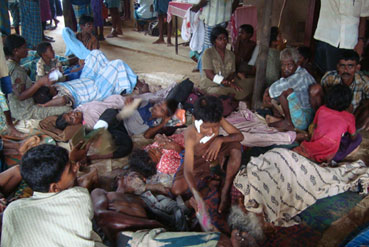
18th May in each year marks the end of a spate of genocide or ethnic cleansing in the Vanni in Sri Lanka.
There must be a UN sponsored international investigation into genocide and ethnic cleansing in Sri Lanka.
People all over the world must lobby their governments aggressively for a UN sponsored international investigation under Chapter 7 of the UN Charter (which permits such an investigation) into allegations of genocide and ethnic cleansing in the Vanni in Sri Lanka, during the war against the insurgency that ended on 18th May 2009.
These allegations are not without substance as shown in the following extracts from the report of the UN Secretary- General’s panel of experts on accountability in Sri Lanka published worldwide on 31st March 2011.
Page 24 paragraph 84 reads:
‘In the early morning hours of 24 January, hundreds of shells rained down in the NFZ. Those with access to the United Nations bunker dove into it for protection, but most IDPs did not have bunkers and had nowhere to seek cover. People were screaming and crying out for help. The United Nations security officer, a highly experienced military officer, and others present discerned that the shelling was coming from the south, from SLA positions.’
NFZ means no fire zone. IDP means internally displaced people. SLA means Sri Lankan Army
Paragraph 85 reads:
‘When United Nations staff emerged from the bunker in the first morning light at the first opportunity, mangled bodies and body parts were strewn all around them, including those of many women and children, Remains of babies had been blasted upwards into the trees. Among the dead were those who had helped to dig the bunker the previous day.’
Page 28 paragraph 100 reads:
‘From as early as 5th February 2009, the SLA continuously shelled within the area that became the second NFZ, from all directions including land, air and sea. It is estimated that there were 300,000 to 330,000 civilians in that small area. The SLA assault employed aerial bombardment, long range artillery, howitzers and MBRLs as well as small mortars, RPGs and small arms fire, some of it fired from a close range. MBRLs are unguided missile systems designed to shell large areas, but if used in densely populated areas, are indiscriminate in their effect and likely to cause large numbers of casualties.’
Page 31 paragraph 105 reads:
‘While individual incidents of shelling took place on a daily basis, destroying the lives of many individuals or families, the SLA also shelled large gatherings of civilians capable of being identified by UAVs. On 25th March, an MBRL attack on Ambalavanpokkani killed around 140 people, including many children. On 8 April 2009, a large group of women and children, who queued up at a milk powder distribution line by the RHDS, were shelled at Ambalavanpokkani. Some of the dead mothers still clutched cards which entitled them to milk powder for their children.’
Page 41 paragraph 132 reads:
‘… A number of credible sources have estimated that there could have been as many as 40,000 civilian deaths. Two years after the end of the war, there is still no reliable figure for civilian deaths, but multiple sources of information indicate that a range of up to 40,000 civilian deaths cannot be ruled out at this stage. …’
APPEAL
I ask that all good people of the world, political, religious, cultural, social, and humanitarian organizations regardless of their race, religion or creed, take notice and lobby their governments to ask for a full investigation by the UN of these terrible crimes against humanity and take appropriate action to bring the wrong doers to justice.

I agree with your call for action.